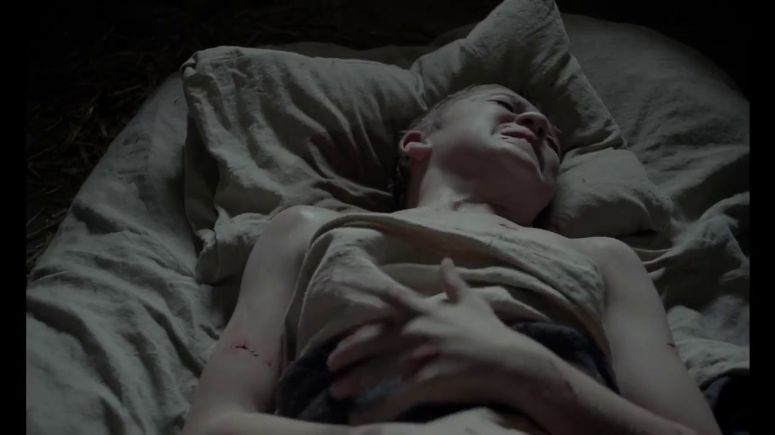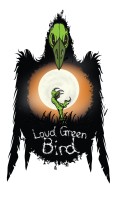
I had to watch Robert Eggers’ THE WITCH: A New-England Folktale a couple of times. After all the talk, I was expecting something overtly shocking and horrifying. I admit after my first viewing, I was disappointed. Another over-hyped film that failed to deliver. But something made me watch it again, and then a third time. THE WITCH is subtle; it builds and stretches the tension. It is an ever-approaching ominous presence hovering just over the shoulder.
The film follows Thomasin (Anya Taylor-Joy) and her Puritan family in 17th century New England. Her father William (Ralph Ineson) has alienated his neighbors with his extremist views. The family is exiled from the relative safety of the settlement into the wilderness. They struggle to survive inner turmoil and an evil force lurking in the woods that surround their small farm. When baby Samuel is stolen by the Witch in the woods while in Thomasin’s care, everyone begins to fall apart.
Thomasin’s grieving mother, Katherine (Kate Dickie), blames her for Sam’s disappearance. She also unleashes her resentment about having left a comfortable life in England for near-starvation in the wild upon Thomasin and convinces William she must be sent away. The young twins Jonas and Mercy begin talking to the goat, Black Phillip, the embodiment of the Devil. Brother Caleb (Harvey Scrimshaw) falls prey to the Witch while trying to save the family.

Eggers based his story on fairy tales and real accounts of supposed witchcraft that took place in colonial America. Puritans believed the Devil was real and the forces of evil were constantly trying to corrupt them. The New World did not always deliver on its promise. It was not the land of milk and honey. There were hardship, uncertainty, illness, and death. The religious and political freedom they sought also often eluded them since they brought the same prejudices and divisiveness with them. William feels this disillusionment when he tells the town elders, “What went we out into this wilderness to find?”
William’s pride and arrogance have doomed his family. He is unable to provide for them; he can’t hunt or trap, the crops are failing, and the animals aren’t producing. As Thomasin tells him, his only skill is cutting wood. He also lacks moral backbone in spite of his preaching. He quizzes son Caleb on the corrupt nature of man, but later lies repeatedly to his wife Katherine and allows Caleb and Thomasin to take the blame.
Thomasin is a catalyst and a scapegoat. Her growing sexuality is a threat to her family. Young women in Puritan communities had value only as wives and mothers. Their sexuality was seen as a gateway to evil and witchcraft. She is burdened with all the repressed resentments, fears, and desires of her parents and siblings. Even Caleb, the best of the family, is struggling with his attraction to her.
Katherine’s treatment of her daughter is the strangest part of the film. As things progress, it becomes clear she harbors a deep fear of Thomasin. Katherine pushes her toward her father in uncomfortable ways and then resents her for it. In the end, Katherine openly accuses Thomasin of being a slut and a whore; of seducing and destroying her brother and father.

Thomasin also seems unsure how to handle her emerging self. She prays, asking for forgiveness for breaking most of the commandments in thought or deed. She lashes out at Mercy, claiming to be the Witch and having the ability to fly and curse. She appears drawn to the woods. Her adolescent angst is used against her as her family seems quick to condemn her for actual witchcraft. In the end, Thomasin is seemingly rewarded. She succumbs to the Devil as he asks, “Wouldst thou like to live deliciously?” She follows him into the woods and becomes part of the coven that has been waiting for her all along.
THE WITCH is Robert Eggers’ first film as writer/director. His skills as a production and costume designer have paid off in the authentic and textured look of the film. The use of candlelight and shadow enhance the feeling of isolation and oppression. Certain scenes, when the actors are still, look like paintings from the period. The wide-angle lens makes the woods seem taller, overarching the small farm. The score, with its alternating drawn-out strings and eerie female wailing, adds to the impression that this family is being stalked.
THE WITCH is a film about impression. There are scenes where you aren’t sure what you are watching, or what they mean. It is heavy with symbolic images. The full effect isn’t felt until the film is over and you begin putting everything together. It’s disturbing and stays with you. Like all folk tales, it is meant to be reexperienced, each time piecing out something different.



Interesting insights into irrational fears of female sexuality and how they drive misogyny!
LikeLike
Thank you! Yes, the mother/daughter relationship was especially disturbing
LikeLiked by 1 person